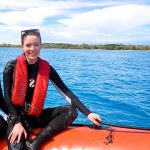The Conservation Value of Coral Reef Biodiversity for the MPA surrounding the Chagos Archipelago
Project Overview
In 2015 the third major bleaching event struck corals reefs globally. According to previous records this was the longest, most widespread and damaging event ever to occur. Unfortunately, both in 2015 and 2016 the Marine Protected Area (MPA) surrounding the Chagos Archipelago was not spared and suffered from back-to-back abnormally high temperatures resulting in severe bleaching and subsequent coral mortality across the whole archipelago.
The Chagos Archipelago’s coral reefs are already showing signs of recovery as juvenile corals appear on the bare skeletons of dead colonies, which are believed to be driven by a high connectivity between atolls. To fully understand these patterns of recovery, we are investigating the population structure of corals across the Chagos Archipelago using genomic techniques. Moreover, we are interested in studying hydrodynamics and temperature regimes surround the archipelago’s reefs in order to better understand the drivers of larval dispersal, population structure and coral reef resilience.
In this region, there is an important proportion of developing countries that directly depend on coral reefs for their citizens’ livelihoods, food security and coastal protection. Yet, the coral reefs of the Indian Ocean are understudied when compared to other regions.
Coral reefs with fewer human impacts and healthy and diverse fish populations recover more quickly from both natural and man-made disturbance events.
Key Facts



News
Publications

Environmental Change and Connectivity Drive Coral Reef Fish Abundance in the Western Indian Ocean
Warmuth, L.M., Kelly, S., Samoilys, M.A., Popova, E., Head, C.E.I., Bonsall, M.B. (2024). Environmental change and connectivity drive coral reef fish abundance in the Western Indian Ocean. ICES Journal of Marine Science

Integration of Population Genetics with Oceanographic Models Reveals Strong Connectivity Among Coral Reefs Across Seychelles
Burt, A., Vogt-Vincent, N., Johnson, H., Sendell-Price, A., Kelly, S., Clegg, S.M., Head, C.E.I., Bunbury, N., Fleischer-Dogley, F., Jeremie, M., Khan, N., Baxter, R., Gendron, G., Mason-Parker, C., Turnbull, L.A. (2024). Integration of population genetics with oceanographic models reveals strong connectivity among coral reefs across Seychelles. Scientific Reports.

Environmental DNA Captures Diurnal Fluctuations of Surface Eukaryotes on a Tropical Coral Reef
Dowell, R., Dunn, N., Head, C., Yesson, C., Williams, J., Ransome, E. (2024). Environmental DNA captures diurnal fluctuations of surface eukaryotes on a tropical coral reef. Environmental DNA.

Remote Reef Cryptobenthic Diversity; Integrating Autonomous Reef Monitoring Structures (ARMS) and In Situ Environmental Parameters
Steyaert, M., Lindhart, M., Khrizman, A., Dunbar, R.B., Bonsall, M., Mucciarone, D., Ransome, E., Santodomingo, N., Winslade, P., Head, C.E.I. (2022). Remote reef cryptobenthic diversity; integrating Autonomous Reef Monitoring Structures (ARMS) and in situ environmental parameters. Frontiers in Marine Science.

Observations of Coral and Cryptobenthic Sponge Fluorescence and Recruitment on Autonomous Reef Monitoring Structures (ARMS)
Steyaert, M., Mogg, A., Dunn, N., Dowell, R., Head, C.E.I. (2022). Observations of coral and cryptobenthic sponge fluorescence and recruitment on autonomous reef monitoring structures (ARMS). Coral Reefs.












